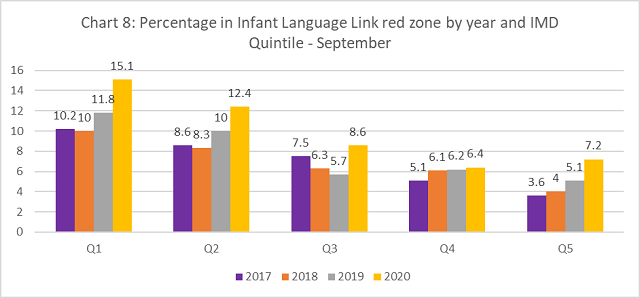The Royal College of Speech and Language Therapist’s (RCSLT) submission to the Centre for Social Justice’s report Two Nations: The State of Poverty in the UK highlights the “insufficiently discussed correlation between speech, language, and communication needs (SLCN) and poverty”.
We must ask why is there so little discussion as many reports have highlighted this connection in the last fifteen years? See our reference list below.
In examining the effects of the pandemic on language levels at school entry our own analysis of Infant Language Link data shows clearly that schools in areas of higher deprivation, as defined by the Index of Multiple Deprivation have more than twice the percentage of children in our “red” zone (approx. < 6th percentile) than schools in the most privileged areas. Importantly this trend is evident in the data for all years prior to and after the pandemic, so whilst the pandemic years increased the magnitude of the problem the disparity is fairly constant.

(IMD quintiles, Q1 to Q5, are derived by combining adjacent deciles, the lowest quintile Q1 represents the most deprived areas. These data are for England and exclude pupils with English as an Additional Language)
Given that speech and language skills are the foundation of literacy and social interaction and are closely aligned with social, emotional and mental health difficulties (SEMH), neglecting these skills and their correlation with poverty will embed disadvantage from an early age through to adulthood. We wonder how many more reports will be needed before both discussion and action follow.
These figures from the RCSLT show both the magnitude of the problem and the extent of the correlation between speech and language and SEMH:
- 81% of children with emotional and behavioural disorders have significant unidentified language deficits.
- People with a primary communication impairment are at greater risk of a secondary mental health disorder, commonly anxiety or depression.
- Children with persistent developmental language disorder from preschool to early primary school may be more likely to have social, emotional and behavioural difficulties (particularly behavioural difficulties).
- Between 40% and 54% of children with behaviour problems have language impairment.
Our Speech Link and Language Link packages have been helping schools support fundamental speech and language skills for over twenty years, it’s the only focus of our dedicated team.
Previous Reports and Studies
Waldfogel, J., & Washbrook, E. V. (2010). Low income and early cognitive development in the UK: A report for the Sutton Trust. London: Sutton Trust
Dockrell, J., Ricketts,J. & Lindsay, G. (2012) Understanding speech, language and communication needs: Profiles of need and provision BCRP 4
All Party Parliamentary Group (APPG) on Speech and Language Difficulties (2013). The links between speech, language and communication needs and social disadvantage.
Save the Children (2014). Read On Get On: how reading can help children escape poverty
Centre for Social Justice (2014). Closing the divide: Tackling educational inequality in England.
Social Mobility and Child Poverty Commission (2014). State of the Nation 2014: Social Mobility and Child Poverty in England report summary.
Save the Children (2016). Early language development and children’s primary school attainment in English and Maths: new research findings.
Public Health England, The mental health of children and young people in England (2016).
Bercow 10 Years On (2018) – An independent review of provision for children and young people with speech language and communication needs in England.
Two Nations: The State of Poverty in the UK.(2023) Centre for Social Justice.
